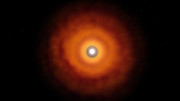the point:
- First tentative detection of prebiotic molecules in a planet-forming disc: In the young V883 Orionis system, ALMA observations have revealed signatures of complex organic compounds such as ethylene glycol and glycolonitrile – potential precursors to sugars and amino acids.
- Chemical evolution begins before planets are formed: The findings suggest that protoplanetary discs inherit and further develop complex molecules from earlier evolutionary stages, rather than forming them anew.
- Evidence for universal processes in the origin of biological molecules: The building blocks of life may not be limited to local conditions but could form widely throughout the Universe under suitable circumstances.
Astronomers have discovered complex organic molecules (COMs) in various locations associated with planet and star formation before. COMs are molecules with more than five atoms, at least one of which is carbon. Many of them are considered building blocks of life, such as amino acids and nucleic acids or their precursors. The discovery of 17 COMs in the protoplanetary disc of V883 Orionis, including ethylene glycol and glycolonitrile, provides a long-sought puzzle piece in the evolution of such molecules between the stages preceding and following the formation of stars and their planet-forming discs. Glycolonitrile is a precursor of the amino acids glycine and alanine, as well as the nucleobase adenine. The findings were published in the Astrophysical Journal Letters today. The assembly of prebiotic molecules begins in interstellar space
The transition from a cold protostar to a young star surrounded by a disc of dust and gas is accompanied by a violent phase of shocked gas, intense radiation and rapid gas ejection. Such energetic processes might destroy most of the complex chemistry assembled during the previous stages. Therefore, scientists had laid out a so-called ‘reset’ scenario, in which most of the chemical compounds required to evolve into life would have to be reproduced in circumstellar discs while forming comets, asteroids, and planets.
"Our finding points to a straight line of chemical enrichment and increasing complexity between interstellar clouds and fully evolved planetary systems." Abubakar Fadul
“Now it appears the opposite is true,” MPIA scientist and co-author Kamber Schwarz points out. “Our results suggest that protoplanetary discs inherit complex molecules from earlier stages, and the formation of complex molecules can continue during the protoplanetary disc stage.” Indeed, the period between the energetic protostellar phase and the establishment of a protoplanetary disk would, on its own, be too short for COMs to form in detectable amounts.
As a result, the conditions that predefine biological processes may be widespread rather than being restricted to individual planetary systems.
Astronomers have found the simplest organic molecules, such as methanol, in dense regions of dust and gas that predate the formation of stars. Under favourable conditions, they may even contain complex compounds comprising ethylene glycol, one of the species now discovered in V883 Orionis. “We recently found ethylene glycol could form by UV irradiation of ethanolamine, a molecule that was recently discovered in space,” adds Tushar Suhasaria, a co-author and the head of MPIA’s Origins of Life Lab. “This finding supports the idea that ethylene glycol could form in those environments but also in later stages of molecular evolution, where UV irradiation is dominant.”
More evolved agents crucial to biology, such as amino acids, sugars, and nucleobases that make up DNA and RNA, are present in asteroids, meteorites, and comets within the Solar System.
Buried in ice – resurfaced by stars
In the Solar System, the Sun heats comets, resulting in impressive tails of gas and dust, or comas, essentially gaseous envelopes that surround the cometary nuclei. This way, spectroscopy – the rainbow-like dissection of light – may pick up the emissions of freed molecules. Those spectral fingerprints help astronomers to identify the molecules previously buried in ice.
A similar heating process is occurring in the V883 Orionis system. The central star is still growing by accumulating gas from the surrounding disc until it eventually ignites the fusion fire in its core. During those growth periods, the infalling gas heats up and produces intense outbursts of radiation. “These outbursts are strong enough to heat the surrounding disc as far as otherwise icy environments, releasing the chemicals we have detected,” explains Fadul.
“Complex molecules, including ethylene glycol and glycolonitrile, radiate at radio frequencies. ALMA is perfectly suited to detect those signals,” says Schwarz. The MPIA astronomers were awarded access to this radio interferometer through the European Southern Observatory (ESO), which operates it in the Chilean Atacama Desert at an altitude of 5,000 metres. ALMA enabled the astronomers to pinpoint the V883 Orionis system and search for faint spectral signatures, which ultimately led to the detections.
Further challenges ahead
“Perhaps we also need to look at other regions of the electromagnetic spectrum to find even more evolved molecules,” Fadul points out. “Who knows what else we might discover?”
Additional information
Other researchers were Jenny K. Calahan (Center for Astrophysics — Harvard & Smithsonian, Cambridge, USA), Jane Huang (Department of Astronomy, Columbia University, New York, USA), and Merel L. R. van ’t Hoff (Department of Physics and Astronomy, Purdue University, West Lafayette, USA).
The Atacama Large Millimeter/submillimeter Array (ALMA), an international astronomy facility, is a partnership of the European Southern Observatory (ESO), the U.S. National Science Foundation (NSF) and the National Institutes of Natural Sciences (NINS) of Japan in cooperation with the Republic of Chile. ALMA is funded by ESO on behalf of its Member States, by NSF in cooperation with the National Research Council of Canada (NRC) and the National Science and Technology Council (NSTC) in Taiwan and by NINS in cooperation with the Academia Sinica (AS) in Taiwan and the Korea Astronomy and Space Science Institute (KASI). ALMA construction and op;erations are led by ESO on behalf of its Member States; by the National Radio Astronomy Observatory (NRAO), managed by Associated Universities, Inc. (AUI), on behalf of North America; and by the National Astronomical Observatory of Japan (NAOJ) on behalf of East Asia. The Joint ALMA Observatory (JAO) provides the unified leadership and management of the construction, commissioning and operation of ALMA.
Contact:
Dr. Markus Nielbock
Press and outreach officer
+49 6221 528-134
pr@mpia.de
MPIA press department
Max Planck Institute for Astronomy, Heidelberg, Germany
Abubakar Fadul
+49 203 379-2208
abubakar.fadul@uni-due.de
University of Duisburg-Essen, Duisburg, Germany
Dr. Kamber Schwarz
+49 6221 528-292
schwarz@mpia.de
Kamber Schwarz / MPIA
class="company">Max Planck Institute for Astronomy, Heidelberg, Germany
Dr. Tushar Suhasaria
+49 6221 528-202
suhasaria@mpia.de
Original publication
Abubakar M. A. Fadul, Kamber R. Schwarz, Tushar Suhasaria, et al.
A deep search for Ethylene Glycol and Glycolonitrile in V883 Ori Protoplanetary Disk
The Astrophysical Journal Letters, Vol 988, L44 (2025)
Source | DOI
T. Suhasaria, S. M. Wee, R. Basalgète, S. Krasnokutski, C. Jäger, K. Schwarz, and Th. Henning
Lyα Processing of Solid-state Ethanolamine: Potential Precursors to Sugar and Peptide Derivatives
The Astrophysical Journal, Vol. 982, id. 48, p. 14 (2025)
Source | DOI
Download
mpia-pm_v883ori_prebiotics_2025_teaser 7.68 MB


















